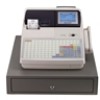Sharp UP-700 Instruction Manual - Page 125
PLU condiment table
 |
View all Sharp UP-700 manuals
Add to My Manuals
Save this manual to your list of manuals |
Page 125 highlights
s PLU condiment table The "condiment entry" is intended to guide the operator in making menu entries which require special cooking instructions. For example, a clerk can make such entries as "garnishing potato," "with salad," and "grilling steak rare." When a clerk enters a menu-item PLU to which PLUs for the condiment entry have been assigned, these orders (such as "garnishing potato") will be printed on the receipt and conveyed to the kitchen. Before you program for the condiment entry, prepare a condiment table. The following shows an example of a condiment table: Condiment table Table number PLU codes for condiment entry (programmed text) Message text 23 01 (HOWCOOK?) (RARE) 25 27 (MED.RARE) (WELLDONE) 02 Message text 44 02 (WITH?) (SALAD) 45 (FRUITS) Message text 33 37 38 04 (POTATO?) (P.CHIPS) (MASHED.P) (BAKED.P) 99 Message text 99 (DRINK?) 63 (TEA) 65 (MILK) 67 (A.JUICE) Condiment tables (Up to 99) PLUs (Up to 15 for a table) The condiment table should contain the following: Next condiment table number Condiment table: The condiment table is a group of condiment PLUs, which is assigned to each menu-item PLU. A table consists of a message text and up to 15 PLUs. Also, you can assign the next condiment table number to a condiment table to link them. The message text is used for displaying a prompting message. The PLU is used for the special order setting. For example, when a clerk enters a menu-item PLU, a display message programmed for the message text such as "HOWCOOK?." will appear. Then specify one of the PLU programmed for text such as "RARE." Table number: The table number is intended to identify each condiment table. NOTE The condiment PLU programmed in a condiment table can be linked with condiment table (Item link method). For example, if PLU 44 (SALAD) in a table of the above is linked with condiment table 10 (SAUCE), when the condiment PLU 44 (SALAD) is registered, items of the condiment table 10 (SAUCE) will be appeared. Table number PLU codes for condiment entry (programmed text) Message text 51 53 10 (SAUCE) (ITALIAN) (FRENCH) 12 Next condiment table number 123















